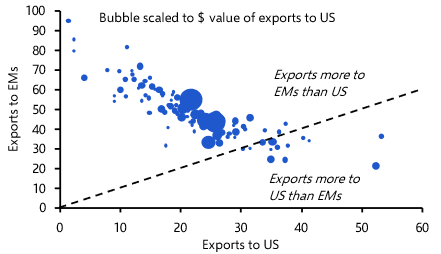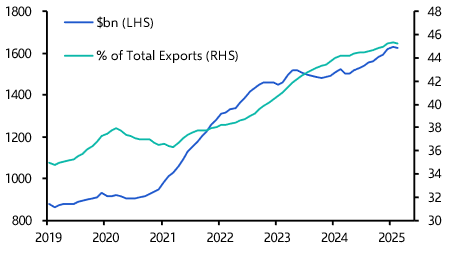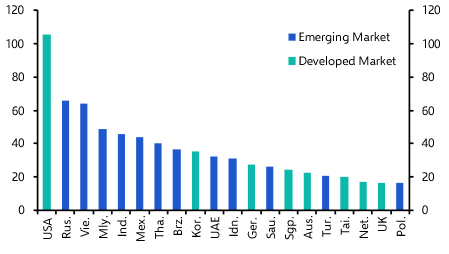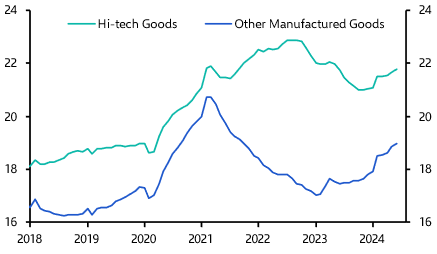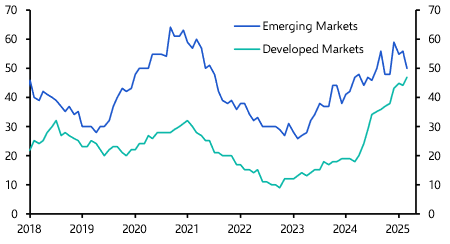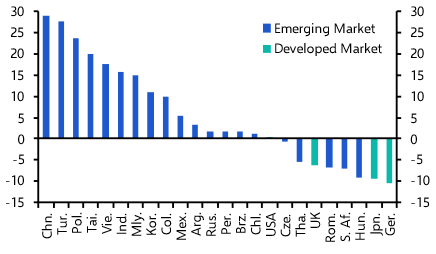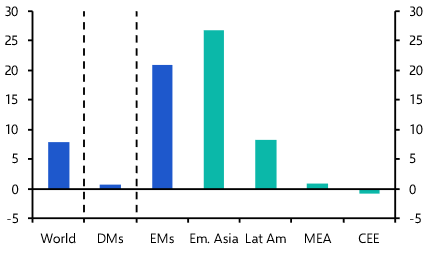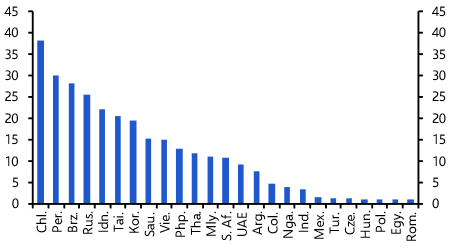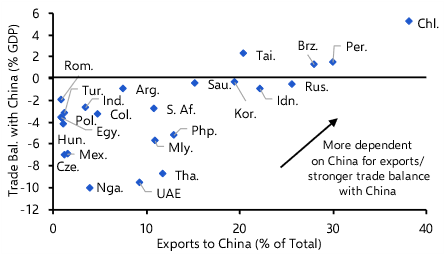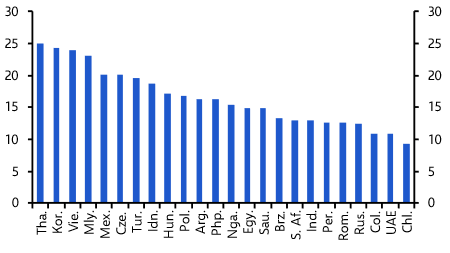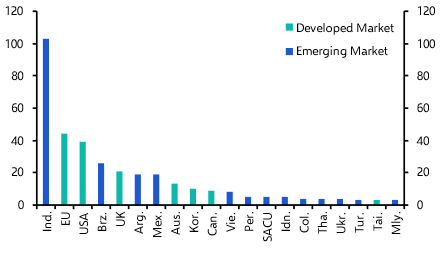- Emerging markets’ imports from China have surged since 2019 and this is likely to continue as punitive US tariffs push Chinese exporters to look to alternative markets. EM governments have, so far, been relatively restrained in their response to this rise in imports. But the US’s turn to protectionism may change their thinking. Those EMs that have large manufacturing sectors and are relatively less dependent on China for export demand are most likely to take steps to protect domestic industry – though in a much more targeted form than across-the-board tariffs.
- Low-cost Chinese exports present several challenges for EMs. If imports from China merely reflect trans-shipments to the US, that raises the threat of higher US import tariffs on the intermediary country. Low-cost imports could also undermine domestic industry, blocking off the well-trodden development path up the manufacturing value chain. Chinese producers will also provide competition in third countries.
- Most EM governments have acted with relative restraint to the surge in imports from China since 2019 – particularly compared with developed economies. But their concerns about the competitive threat from China appear to be growing. And the US’s protectionist shift may embolden policymakers in EMs to take a more aggressive approach towards protecting domestic industry.
- The likelihood of a response will vary across countries, depending on a number of factors including the strength of a country’s political relationship with China, its dependence on Chinese demand (and concerns about retaliation) and the size of the manufacturing sector.
- And the type of policy response is also likely to vary, depending on the perceived challenge from China. For economies with large domestic markets, import tariffs might be adopted, although we doubt that EMs would follow the US policy of across-the-board tariffs. Policymakers are likely to adhere to WTO rules and use tariffs in a targeted way.
- India is one economy that fits the bill. It has strained political relations with China, aspirations to expand in high-tech sectors such as electronics, and a large domestic market. And it has already frequently introduced anti-dumping measures on China.
- For highly-open economies, imposing tariffs on imports from China might be less effective. Their home markets are a relatively small part of overall demand for their manufacturers; the bigger threat is competition in third markets. They may be more likely to adopt industrial policies aimed at boosting domestic producers’ competitiveness (although these are currently comparatively rare in EMs) and seek trade deals with key export markets.
- Meanwhile, we suspect that a large number of commodity-driven countries will refrain from taking significant measures against China, given their dependence on Chinese demand and concerns about retaliation. This is particularly the case for parts of sub-Saharan Africa and Latin America.
How will EMs respond to rising imports from China?
Emerging markets have played a big role over the past five years in absorbing China’s export boom, and this is likely to continue as punitive US tariffs push Chinese producers to seek alternative markets. So far, EM governments have taken a relatively restrained approach in terms of protecting their own producers. This Focus looks at whether they will take a more protectionist stance in the face of the next wave of Chinese exports.
Trump’s tariffs to push more Chinese exports to EMs
The US Court of International Trade’s (CIT’s) decision to overrule President Trump’s use of emergency powers (via the IEEPA) to impose tariffs – and the subsequent court ruling to temporarily stay the tariffs – has thrown the trade war into disarray.
While the appeals process plays out, our working assumption is that tariffs will remain around current levels (40% on China, and an average of 10% on everyone else). There’s a very high level of uncertainty about where tariff rates end up, but we can be reasonably confident that China will face sustained higher tariff rates than any other country.
After all, if the CIT’s ruling is upheld, Trump’s tariffs imposed via emergency powers remain in place – and China faces higher tariffs than everyone else. And if the ruling is overturned, the Trump administration has more legal pathways to prosecute its trade war by raising tariffs on China than on other countries. In this situation, if anything, Trump might even shift more of the tariff burden onto China than other countries – especially in light of his complaints that China ‘violated’ the agreement made in Geneva in May that led to a reduction in tariff rates imposed on each other. (See our China Weekly.)
A 40% US import tariff on China might plausibly reduce Chinese exports to the US by 25-30%, or some $120bn. In the face of punitive tariffs, China’s exporters will undoubtedly be looking to either re-route exports intended for the US via third countries or seek other sources of final demand. (See our recent in-depth report.) The April trade figures out of China provided some early signs that US tariffs are pushing its exports towards EMs. Although exports to the US fell, that was more than offset by a rise in exports elsewhere – particularly to ASEAN, India and Latin America.
And EMs are suitable markets for Chinese producers looking to re-direct shipments from the US. Chart 1 shows the largest 100 products (at a four-digit HS code level) that China sells to the US (which accounted for about 80% of its exports to the US last year). The horizontal axis shows the share of China’s total exports of that product that go to the US; the vertical axis shows the share that goes to EMs.
|
Chart 1: China Goods Exports to EMs and to US by Product (% of Total Exports of Product, 2024) |
|
|
|
Sources: LSEG, Capital Economics |
China ships more of almost all these products (87 out of 100 categories) to EMs than to the US – the circles above the dashed line. In other words, there’s a lot of overlap between the products China sells to the US and those that it sells to EMs.
For emerging markets, a rise in imports from China would continue a trend that’s been underway for some time. China’s exports have boomed since the pandemic on the back a wave of investment in industrial capacity that couldn’t be absorbed by its domestic market. That prompted producers to cut prices and look abroad. As a result, China’s goods exports have risen by ~$1 trillion since 2019.
And emerging markets played a key role in China’s export boom, receiving around 70% of the increase in exports. Russia, Vietnam, Malaysia and India have – after the US – been the largest growth markets for China in dollar terms over the past five years. (See Charts 2 & 3.) The ~$120bn decline in Chinese exports to the US that we estimate will arise from tariffs is smaller than the average annual increase in EM imports from China since 2019.
|
Chart 2: China Goods Exports to EMs (12m Sum) |
Chart 3: Change in China’s Goods Exports by Destination (2019-24, $bn, Top 20) |
|
|
|
|
Sources: LSEG, Capital Economics |
Sources: Intracen, Capital Economics |
A threat to the growth outlook?
Low-cost imports from China might be welcomed to the extent that they help to reduce inflation and boost purchasing power. But given how far Chinese producers have lowered prices, it seems unlikely that goods price disinflation will strengthen. And there are a number of challenges for EMs posed by low-cost Chinese exports.
For one thing, if Chinese exports are routed to an EM in order to be shipped on to the US (trans-shipments), that could put the country in question into the US’s crosshairs in the future with very little economic benefit in return. After all, the reciprocal tariff rates announced by the Trump administration were based on a calculation that took account of a country’s bilateral trade balance with the US. And the Trump administration is clearly keeping a close eye on possible trade re-routing, as evidenced by punitive tariffs on solar panel imports from other parts of Asia. (You can monitor Chinese re-routing to the US on our interactive dashboard here.)
Low-cost Chinese imports could also undermine domestic industry and block the well-trodden development path of rising up the manufacturing value chain. In this regard, it’s worth noting that China’s export surge hasn’t just been concentrated in new technologies like batteries or EVs; China has also gained global market share in lower value added industries such as textiles. (See Chart 4 and here.) Finally, China’s exports will also compete with other emerging markets’ exports in third countries.
|
Chart 4: China Global Export Market Share (%, 12m Average) |
|
|
|
Sources: UN, ITC, LSEG, Harvard Growth Lab, Capital Economics |
EM response may be milder than the DM response
So far, policymakers in emerging markets have been relatively restrained in their response to rising imports from China – particularly compared to DM policymakers. According to data compiled by Global Trade Alert, while there has been a steady rise in anti-dumping measures taken against China by emerging market governments, the number of measures taken by developed market governments has risen much more sharply. (See Chart 5.)
|
Chart 5: Number of Anti-Dumping Measures taken Against China (12m Rolling Sum) |
|
|
|
Sources: Global Trade Alert, Capital Economics |
One possible explanation is that EM governments haven’t felt threatened by the competition from China to the same extent as those in DMs. Industry and exports in emerging markets have generally fared better in recent years. (See Charts 6 & 7.) And manufacturing sectors in some EMs – including Mexico and parts of Asia – appear well placed to benefit in the near term from a re-direction of US import demand away from China.
|
Chart 6: Industrial Production (%-Change, 2019-24) |
Chart 7: Goods Export Volumes (%-Change, 2019-24) |
|
|
|
|
Sources: LSEG, Capital Economics |
Sources: Intracen, Capital Economics |
And EMs may not feel as threatened about a potential shift in Chinese exports away from the US given the extent to which their trade ties with China have expanded over the past five years.
Still, concerns in EMs about competition from China do appear to be growing – as evidenced by the rise in anti-dumping measures imposed on China. And the US’s protectionist shift may embolden policymakers in EMs to take a more aggressive approach towards protecting domestic industry. China’s recent diplomatic efforts, such as with the Gulf and Latin American economies, suggest that it too is worried that other countries might try to close the door to its exporters.
Likelihood of a response will vary across countries
Some EM governments may face pressure from the US to put import tariffs on goods from China as part of any trade deal. Mexico’s government has reportedly already offered to do this. We looked at this idea in more detail here: the short point is that we’re sceptical that US coercion will be effective outside of cases in which economies are very dependent on US demand (like Mexico).
And insofar as the UK-US trade ‘deal’ is a blueprint, the Trump administration’s trade agreements may focus on excluding China from supply chains in strategically-important goods, rather than demanding that other countries impose broad-based tariffs on China. (See here.)
Nonetheless, EM policymakers could turn to protectionist measures against China for domestic reasons. The likelihood of a response will depend on several factors. The first is a country’s geopolitical alignment with China. Close allies of China are less likely to impose protectionist measures than countries that are more aligned with the US. (See Chart 8. Interactive data on geopolitical alignments can be found on our Global Fracturing dashboard.)
|
Chart 8: CE Classification of Geopolitical Alignments |
|
|
|
Source: Capital Economics |
Of course, close geopolitical ties don’t rule out the possibility of trade protectionism. Russia, for example, sharply increased ‘recycling’ fees on new cars last year, which act to protect domestic producers from foreign competition (the fee for domestic producers is almost entirely reimbursed via subsidies). But that should be viewed in terms of the dramatic surge in China’s car exports to Russia since 2022. Chinese auto makers went from a 6.9% share of Russia’s car sales in 2021 to over 60% last year, squeezing out Russian makers.
The second factor is a country’s dependence on China for foreign trade. For some EM commodity producers such as Brazil and Indonesia, exports to China account for more than 20% of total exports. For copper producers like Chile and Peru, it’s more than 30%. (See Chart 9.)
|
Chart 9: Goods Exports to China (% of Total, 2024) |
|
|
|
Sources: LSEG, Capital Economics |
These countries would probably be wary of imposing protectionist measures on China in case of Chinese retaliation. After all, there’s no country other than China that can buy the commodities that they produce in such large quantities. In any case, these are generally economies that have also benefitted from a rise in exports to China. And as a result, unlike much of the world, they don’t run large goods trade deficits with China. (See Chart 10.)
|
Chart 10: China Share of Total Exports & Trade Balance with China (2024) |
|
|
|
Sources: LSEG, Capital Economics |
In contrast, countries such as Mexico and India have seen a much more lopsided rise in trade with China; imports from China have surged, yet they export little to China, and so are much less likely to be concerned about the impact of any retaliation.
Lithuania’s experience in 2021 is instructive (albeit extreme). It allowed Taiwan to open a representative office in Vilnius. China retaliated by cutting imports from Lithuania by over 90% in the subsequent six months. But Lithuania was probably confident that it could risk triggering such a backlash given that China only accounted for about 1% of its exports.
The final factor that will be key in determining policymakers’ response is the size of the manufacturing sector that might be threatened by China. These sectors are particularly large in Central and Eastern Europe, Mexico and South East Asia. (See Chart 11.) The larger the manufacturing sector, the greater the political pressure to support it will be.
|
Chart 11: Manufacturing (% of GDP, 2023) |
|
|
|
Sources: World Bank, Capital Economics |
Of course, in practice things are more complex than this. There may be certain manufacturing sub-sectors that certain economies are particularly keen to protect from Chinese competitors. Conversely, an economy without domestic production capacity in a specific sector may have no need to impose tariffs on those imports and may be more likely to welcome lower-cost imported goods. Many EMs, for example, don’t have domestic auto sectors so would presumably be keen to accept lower-cost imports.
And the type of response will vary too
The nature of any response to protect domestic industry is likely to vary, depending on the nature of the challenge posed by Chinese producers.
For those EMs with large domestic markets, tariffs on imports from China might be the policy of choice. We doubt that trade measures against China will follow the US policy of across-the-board tariffs. Policymakers are more likely to try to adhere to WTO rules, focusing measures on specific products.
India is one economy that stands out in this regard. It has strained political relations with China, aspirations to expand in high-tech sectors such as electronics, and a large domestic market. And it also has a track record of putting barriers up against Chinese products. According to the Global Trade Alert database, India has enacted far more anti-dumping measures against China than any other country or bloc in recent years. (See Chart 12.) We suspect that Mexico could fall into this camp too (if the US hasn’t already forced its hand).
|
Chart 12: Number of Anti-Dumping Measures taken Against China Since 2020 |
|
|
|
Sources: Global Trade Alert, Capital Economics |
In contrast, highly-open economies in parts of Eastern Europe and Asia may find tariffs to be an ineffective instrument in terms of protecting their manufacturers from Chinese competition. After all, their home markets form a relatively small part of their manufacturers’ overall demand. The main threat arises from competition in third markets.
Policymakers may turn to industrial policies such as low-cost lending and tax breaks to help domestic firms to compete with Chinese producers. Research from the IMF suggests that such policies are currently comparatively rare in emerging markets, but it seems plausible that they could become more common.
Policymakers may also seek trade deals with key export markets to give their producers an edge in third countries. The case of the Central and Eastern European economies is complicated by EU restrictions on state aid and a common tariff policy. But their governments could seek exemptions or exert pressure for EU-wide industrial policies or import tariffs on Chinese goods (supporting their competitiveness in key markets in Western Europe).
In some cases, governments may seek investments from China as a trade-off for not imposing tariffs. That would keep the market open for China, but would require more value added to be made in the emerging market in question.
Meanwhile, we suspect that a large number of commodity-driven countries will refrain from taking significant measures against China, given their dependence on Chinese demand. This is particularly the case for parts of sub-Saharan Africa and Latin America.
